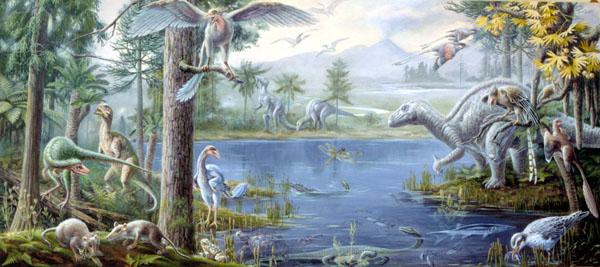As dinosaurs did not always enjoy mild climates, it has long been thought that the climate of the Mesozoic, the age of the dinosaurs, was generally warm across the planet. However, a recent study challenges this theory.
Dr. Romain Amiot, a French postdoc fellow who worked with Dr. ZHOU Zhonghe at Institute of Vertebrate Paleontology and Paleoanthropology, Chinese Academy of Sciences, and Dr. DING Zhongli at Institute of Geology and Geophysics, Chinese Academy of Sciences, and his other collaborators from China, France, Japan and Thailand , analyzed the oxygen isotope composition of apatite phosphate ( 18Op) from various reptile remains recovered from the Early Cretaceous deposits in China (where the Jehol fauna developed), Thailand and Japan, to determine the temperatures at that time. The results indicate that cold terrestrial climates prevailed at least in the region of north-east China during the Early Cretaceous (between 125 and 110 million years ago). Estimated mean air temperatures of about 10 4 C at midlatitudes ( 42 N) correspond to present day cool temperate climatic conditions (such as the climate in Beijing today). Their work is published on the PNAS website this week.
Amiot and his team based their analysis on the principle that the average local air temperature determines the relative quantity of oxygen isotopes contained in the rainwater drunk by the animals. This isotope record is passed on and stored within the bones and teeth of animals as they grow. Since the oxygen contained in the mineralized tissue is preserved during fossilization, the researchers were able to reconstruct the prevailing air temperatures in the environment of Asian dinosaurs during the Early Cretaceous.
The results show that the Jehol fauna, including many dinosaurs covered with filamentous structures similar to bird feathers (such structures can take on various forms, ranging from filaments, down and 'protofeathers' to true feathers), lived in a cool temperate climate characterized by harsh winters during which cold-blooded reptiles (turtles and lizards) had to hibernate, whereas the down, feathers and fur of warm-blooded animals (mammals, birds and dinosaurs) enabled them to maintain sustained activity in winter. "These results do not prove in any way that feathers appeared because of their insulating characteristics. They show that feathers would have given the dinosaurs of the Jehol fauna a physiological advantage over their fellow animals with scales," said Amiot, lead author of the paper, currently holding a research position at the Laboratoire de g ologie de Lyon (ENS de Lyon/Universit de Lyon 1/CNRS).
"Such low temperatures are in agreement with previous reports of cold marine temperatures during this part of the Early Cretaceous, as well as with the widespread occurrence of the temperate fossil wood genus Xenoxylon and the absence of thermophilic reptiles such as crocodilians in northeastern China. The unique character of the Jehol Biota is thus not only the result of its evolutionary and biogeographical history but is also due to rather cold local climatic conditions linked to the paleolatitudinal position of northeastern China and global icehouse climates that prevailed during this part of the Early Cretaceous , said Dr. ZHOU, A climatic gradient similar in some respects to the present one may at least partly explain the differences between the Jehol Biota and floral and faunal assemblages from regions located farther South.
"To date, possible relations between global climatic conditions and the taxonomic composition of the Jehol Biota have not been investigated, and no quantitative local climate reconstruction has been proposed so far. This work helps us to better understand the Early Cretaceous period, and sheds new light on existing theories about the Earth at the time of the dinosaurs , said Dr. WANG Xu, coauthor, Institute of Geology and Geophysics, Chinese Academy of Sciences.
This work was supported by the Chinese Academy of Sciences, the National Natural Science Foundation of China (Grants 40730208, 40502019, and 40862001), the Major Basic Research Projects (2006CB806400) of MST (Ministry of Science and Technology) of China, the French CNRS ECLIPSE II programme, and a Thai-French joint project (PHC n 16610UJ).

Fig.1: Reconstruction of ecosystem of the Jehol fauna (Image by IVPP)
Related News
- Nationwide Videophone Conference on the Work of Special Inspection on the Implementation of Government Procurement Held (Photos)
- Ma Wen Exclusively Interviewed by Xinhua Net
- Ma Wen Spoke at the National Videophone Conference on the Special Task of Prohibiting Overseas Travel on Public Funds: Improving the Systems, Fulfilling Responsibilities and Strengthening Supervision to Ensure Prominent Progress of the Special Task
- The Second Joint Conference of Corruption Prevention: Adhering to the guidance of the Scientific Outlook on Development to Deepen the Work of Corruption Prevention (Photos)
Photos
More>>trade
- The Second Conference of States Parties to the United Nations Convention against
- Representatives of the Workshop of Corruption Prevention for Asian and African
- The Workshop of Corruption Prevention for Asian and African Countries Came Back
- He Yong Met With Representatives of the Workshop of Corruption Prevention for
- The Workshop of Corruption Prevention for Asian and African Countries Successful
market
- The First Phase of Special Discussion of the Workshop of Corruption Prevention
- Students of the Workshop of Civil Servants of Hong Kong Visited NBCP
- Fujian convenes working conference on corruption prevention
- National Roving Seminar on PCT Held in Xi'an
- Shaanxi IP Administration Launches Patent Administrative Law-Enforcement
finance
- Chinese-Foreign Symposium on "IPR System and Protection" Held in Ji'nan
- Guangzhou's First District-Level IPR Protection Association Established
- China International Industrial Design Forum Held in Wuxi
- Sino-UK IP Forum Held in Hangzhou, Zhejiang Province
- Seminar about Practice of Intellectual Property Right in Europe and Germany Held





